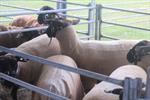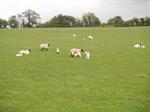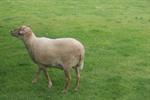
Improve Sheep Production by increasing your knowledge and skills.
This course examines:
Wool is an export product so good prices can be obtained when conditions in the market are favourable. There are fewer marketing problems associated with wool of good-high quality. Pure mutton breeds require less management than pure wool breeds. The lamb market is strong in many countries. A dual purpose breed can provide the farmer with two products (meat and wool), and spreads the farmer's source of income should there be an overproduction one of the two products. Sheep can also be farmed for dairy (e.g. sheep cheese can be as popular as cows cheese in some parts of the world. Learn more by enrolling now.
COURSE CONTENT
There are 8 lessons in this course:
Lesson 1: Introduction: Terminology and Breeds
- Factors affecting the choice of breed
- Product and Market
- Rearing and Management System
- Overview of Sheep Breeds
- Sheep Terminology
Lesson 2: Selection and Breeding
- Growth Rate
- Reproductive Efficiency
- Carcass quality
- Wool traits
- Culling old ewes
- Selecting replacement ewes
- Selecting replacement rams
- Commercial Sheep Production
- Choosing a lambing time
- Autumn lambing
- Spring lambing
- Accelerated lambing
- Managing ewes prior to mating
- Using hormones to control reproduction
- Joining methods
- Anatomy of ewe reproductive organs
- Anatomy of ram reproductive organs
- Ultrasound
- Signs of lambing
 Lesson 3:Nutrition of sheep
Lesson 3:Nutrition of sheep
- Anatomy
- Condition scoring
- When to condition score
- Factors affecting feed requirements
- Feeding rams
- Feeding ewes
- Feeding lambs and fatteners
- Nutrition and wool production
Lesson 4: Diseases in sheep
- Viral and rickettsial diseases
- Bacterial diseases
- Metabolic diseases
- Protozoal diseases
- Poisoning
- Vaccination
- The medicine chest
- Giving injections
- Disease prevention through sound management
Lesson 5: General management of flocks
- Handling and treatment facilities
- Drenching
- Injecting
- Hoof Trimming
- Shearing
- Tail docking
- Castration
- Blowfly strike
Lesson 6: Care of lamb
- Abnormal Presentation
- Presentation: One front leg back
- Presentation: Both front legs back
- Presentation: Hind legs first
- Presentation: Head back, both front feet forward
- Presentation: Breech or tail first
- Presentation: Twin lambs presented together
- Post lambing care
- Drenching
- Rearing orphan lambs
- Lambing records
- Managing the fattening lamb
- Feeding
- Lamb marking
 Lesson 7: Wool
Lesson 7: Wool
- Characteristics of wool
- Types of wool
- Wool classing
- Wool processing
- Factors influencing the estimation of yield
- Piece Picking
- Wool Scouring
- Carding
Lesson 8: The marketing of sheep and sheep products
- Wool sales
- Sale by private treaty
- The auction system
- Wool futures
- Industry regulatory and marketing authorities
- Lamb and mutton marketing: Paddock sale, Sale yard auction, Over-the-hook sale
- Electronic Marketing, Live Sheep exports, Forward price contracts
- Factors affecting the value of lamb or mutton: Carcass weight, Skin value, Payment basis (hot or cold weight) etc.
Feeding Sheep Well
Sheep are primarily grazers. They are ruminants and have a compound stomach made up of four organs: the rumen, the reticulum, the omasum and the abomasum. The abomasum is the "true" stomach.
Digestion takes place by a combination of mechanical and chemical methods.
Nutrition and feeding
The amount of food that sheep require depends on a number of factors.
- The Animal's Production - ewes which are empty and rams which are not working will require only a basic maintenance ration. Ewes that are in milk or rearing a lamb will require more food, as will lambs being fattened for market.
- The Environment - grazing animals require 20% more energy than those kept in pens. Cold weather conditions may increase the need for food; but high temperatures can cause stress on an animal and reduce feeding.
Vitamins and Minerals
Sheep require calcium and phosphorus in fairly large quantities although not as much as cattle do. The reason for this is that sheep have a shorter gestation and lactation period and a longer time between weaning and re-conception than in cattle. This gives the sheep more time to make up calcium and phosphorus losses. In addition, sheep graze more selectively than cattle and are able to satisfy most of their mineral needs. Ewes' milk is high in phosphorus which protects the lambs from deficiency. Two periods when phosphorus needs of the ewe are relatively high are in late pregnancy and during lactation.
Minerals for sheep can be provided in two ways:
1. Loose minerals – where they are added to the feed or offered in a separate mineral feeder.
2. Mineral block for sheep has the ingredients formed into solid blocks.
Sheep are sensitive to copper, as little as 20ppm can prove toxic to them. So make sure any mineral supplements you provide do not have added copper.
Vitamins A, D and E may need to be included in sheep rations.